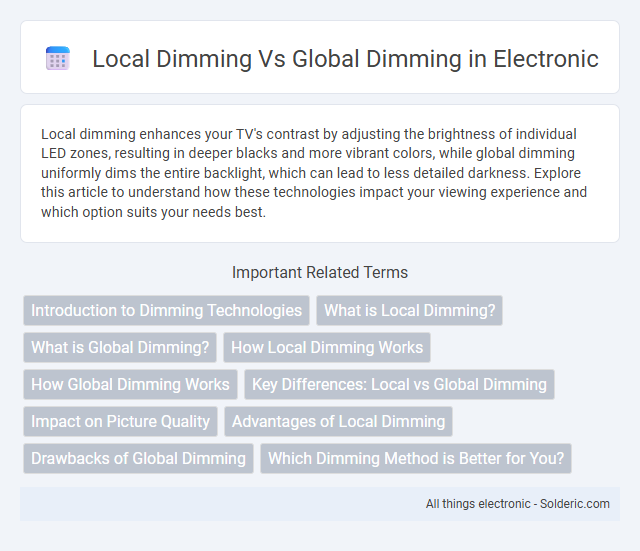Local dimming enhances your TV's contrast by adjusting the brightness of individual LED zones, resulting in deeper blacks and more vibrant colors, while global dimming uniformly dims the entire backlight, which can lead to less detailed darkness. Explore this article to understand how these technologies impact your viewing experience and which option suits your needs best.
Comparison Table
| Feature | Local Dimming | Global Dimming |
|---|---|---|
| Definition | Adjusts backlight in specific screen zones for better contrast | Controls brightness uniformly across the entire screen |
| Contrast | Higher contrast with deeper blacks | Lower contrast, less precise black levels |
| Power Efficiency | More efficient by dimming only needed zones | Less efficient due to uniform brightness control |
| Brightness Control | Zone-based dimming for detail preservation | Whole-screen dimming, less detailed |
| Picture Quality | Improved HDR performance and image depth | Limited HDR impact and flatter image |
| Use Case | High-end TVs, gaming monitors, HDR content | Basic displays, energy-saving modes |
| Potential Issues | Halo effects around bright objects | Uniform dimming may cause washed-out visuals |
Introduction to Dimming Technologies
Local dimming enhances contrast by independently controlling the brightness of individual zones or LED clusters within an LCD backlight, resulting in deeper blacks and improved picture quality. Global dimming adjusts the backlight intensity uniformly across the entire screen, which can reduce power consumption but often leads to less precise contrast and diminished detail in dark scenes. Advanced displays often combine local dimming with high dynamic range (HDR) technology to maximize visual performance and energy efficiency.
What is Local Dimming?
Local dimming enhances your TV's picture quality by selectively dimming backlight zones in darker areas of the screen, resulting in deeper blacks and improved contrast. Unlike global dimming, which adjusts the entire screen's brightness uniformly, local dimming uses multiple dimming zones to deliver more precise lighting control. This technology is especially beneficial in LED and LCD displays, where it reduces halo effects and enhances overall visual clarity.
What is Global Dimming?
Global dimming refers to a display technology where the backlight is uniformly dimmed or brightened across the entire screen, affecting all pixels equally. This method reduces overall power consumption and improves black levels but can cause loss of detail in dark scenes due to the lack of localized control. Unlike local dimming, global dimming cannot adjust brightness in specific screen zones, resulting in less contrast and deeply shadowed image quality.
How Local Dimming Works
Local dimming works by dividing the LCD backlight into multiple zones that can be independently dimmed or brightened to improve contrast and black levels. This technology enhances picture quality by selectively reducing light in dark areas while keeping bright areas illuminated, resulting in deeper blacks and more vibrant colors. Your viewing experience benefits from increased dynamic range and reduced halo effects compared to global dimming, which adjusts the backlight uniformly across the entire screen.
How Global Dimming Works
Global dimming adjusts the brightness of an entire backlight uniformly to reduce overall screen luminance and improve contrast in darker scenes. This method controls the LED backlight as a single zone, resulting in less precise light control compared to local dimming. While simpler and more cost-effective, global dimming can lead to diminished image detail in shadowed areas due to limited contrast enhancement.
Key Differences: Local vs Global Dimming
Local dimming adjusts the brightness of individual LED zones behind the screen, enhancing contrast by darkening specific areas while keeping others bright, which results in deeper blacks and improved image quality. Global dimming, on the other hand, controls the brightness of the entire backlight uniformly, limiting contrast improvements but reducing power consumption and extending display lifespan. The key difference lies in precision: local dimming provides targeted brightness control for better picture clarity, whereas global dimming offers a simpler, less dynamic approach to screen illumination.
Impact on Picture Quality
Local dimming enhances picture quality by allowing precise brightness control in specific screen areas, resulting in deeper blacks and improved contrast compared to global dimming, which uniformly dims the entire screen. This targeted adjustment reduces halo effects around bright objects and delivers richer colors, especially in HDR content. Your viewing experience benefits from sharper details and more dynamic images with local dimming technology.
Advantages of Local Dimming
Local dimming enhances contrast and black levels by independently controlling the backlight in specific zones, resulting in deeper blacks and more vibrant images. This technology improves HDR performance by reducing halo effects and boosting brightness where needed, offering a superior viewing experience compared to global dimming. Your display benefits from increased energy efficiency and reduced light bleed, making local dimming a preferred choice for high-quality TVs and monitors.
Drawbacks of Global Dimming
Global dimming often results in uneven brightness and reduced contrast due to the uniform dimming of the entire backlight, which can cause dark scenes to appear gray and dull. This lack of precision leads to halo effects around bright objects, diminishing overall image quality and detail. In comparison, local dimming provides better contrast by independently controlling smaller backlight zones, but global dimming's simplicity restricts dynamic range and visual depth.
Which Dimming Method is Better for You?
Local dimming offers superior contrast and deeper blacks by independently controlling individual LED zones, enhancing your viewing experience in dark scenes. Global dimming adjusts brightness uniformly across the entire screen, which can lead to washed-out images in high-contrast content. Your choice depends on whether you prioritize picture quality with dynamic lighting or prefer a cost-effective option without complex backlight zones.
Local dimming vs Global dimming Infographic

 solderic.com
solderic.com